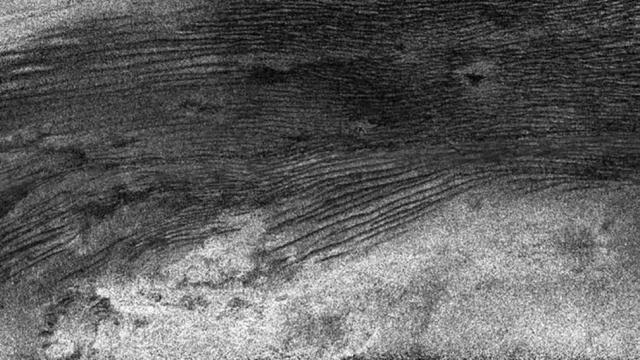The equatorial dunes on Saturn’s moon Titan are among the most dramatic surface features in the Solar System, but scientists aren’t exactly sure how they formed. New experimental evidence suggests the dunes arose as a result of cosmic rays hitting Titan’s surface ice.
Titan is one of the neatest places in the Solar System. It’s a Saturnian moon that features a dense atmosphere, liquids at the surface in the form of hydrocarbon lakes and seas, enormous dust storms, and ice volcanoes that spew jets of water instead of molten lava.
Titan also features an equatorial desert, called the Shangri-La Sand Sea, that’s home to a network of monumental dunes, the tallest of which reach as high as 100 metres. Using NASA’s Cassini spacecraft and the ESA’s Huygens lander, researchers have been able to observe these dunes, which extend across an area measuring over 10 million square kilometres.
On Earth, sand dunes are composed primarily of silicates, but the dark dunes on Titan are built from organic materials, the origin and composition of which remain unknown.
Previous research suggested these organics were created in Titan’s atmosphere, the result of a chain reaction involving methane, nitrogen, and solar photons. Born in the sky, these particles rained down onto the desert’s surface, providing the substrate for the dunes over geological timescales.
New research published this week in Science Advances presents a new explanation, suggesting the particles formed directly on Titan’s surface due to complex chemical reactions triggered by the steady bombardment of interstellar cosmic rays.
Thanks to our trusty magnetosphere, Earth’s surface is protected from this type of radiation, but the same can’t be said for Titan, which can only rely on its thick atmosphere to absorb the incoming radiation.
Physical chemist Ralf Kaiser from the University of Hawaii and his colleagues conducted an experiment to see if frozen acetylene — a chemical compound used in welding — could be converted into complex organic molecules like the ones seen on Titan, specifically benzene and naphthalene. This research was prompted by prior observations of acetylene ice in regions near Titan’s dunes.
To simulate the effects of cosmic rays, the researchers blasted their samples with high-energy electrons and then heated this chemically converted product to the point of sublimation (when solids turn directly into gas) for chemical analysis. The experiment produced the desired effect, turning the acetylene into dark organic gunk, or more technically, polycyclic aromatic hydrocarbons (PAHs) containing up to three or four carbon rings.
The new research shows that PAHs, including naphthalene and phenanthrene and its precursors benzene, phenylacetylene, and styrene, can be synthesised by irradiating frozen acetylene — a process that might be happening on Titan’s surface and subsequently acting as “as a critical molecular feedstock to the organic dune material,” the authors wrote in the study.
This is obviously not proof that the dunes on Titan were produced in the same way, but it represents an intriguing possibility — both for Titan and for other places in the solar system, including celestial bodies devoid of atmospheres. In the same press release, Matthew Abplanalp, a co-author of the study, said “unravelling the origin and chemical pathways to form this organic dune material is vital not only to understand Titan’s chemical evolution, but also to grasp how alike the chemistries on Titan and on Earth might have been like before life emerged on Earth 3.5 million years ago.”
We’re still not completely certain where the dune materials came from or what they’re made of, but NASA’s Dragonfly aerial drone could uncover more clues to this mystery, as the initial phase of the mission will see the probe investigate a series of sand dunes. Sadly, we’re going to have to wait a while, as Dragonfly won’t take to Titan’s hazy golden skies until the mid-2030s.
